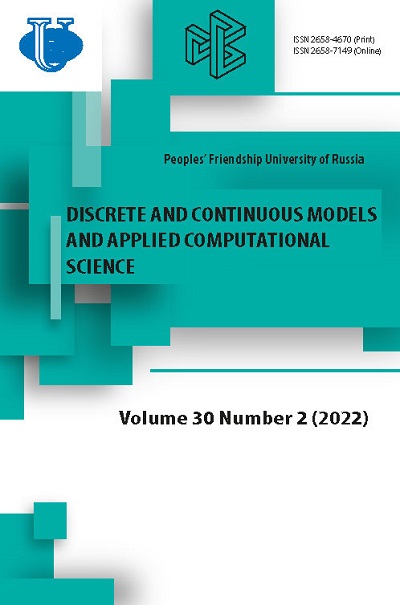Numerical solution of Cauchy problems with multiple poles of integer order
- Authors: Belov A.A.1,2, Kalitkin N.N.3
-
Affiliations:
- Lomonosov Moscow State University
- Peoples’ Friendship University of Russia (RUDN University)
- Keldysh Institute of Applied Mathematics RAS
- Issue: Vol 30, No 2 (2022)
- Pages: 105-114
- Section: Articles
- URL: https://journals.rudn.ru/miph/article/view/30949
- DOI: https://doi.org/10.22363/2658-4670-2022-30-2-105-114
Cite item
Full Text
Abstract
We consider Cauchy problem for ordinary differential equation with solution possessing a sequence of multiple poles. We propose the generalized reciprocal function method. It reduces calculation of a multiple pole to retrieval of a simple zero of accordingly chosen function. Advantages of this approach are illustrated by numerical examples. We propose two representative test problems which constitute interest for verification of other numerical methods for problems with poles.
Full Text
1. Introduction There are a number of important applied problems in which the solution has multiple singularities. In such problems, it is required to find a chain of sequentially located singularities. Similar problems are often found in the theory of special functions (elliptic functions, gamma function, etc.). Numerical methods are widely used to compile tables of special functions [1] and for standard direct calculation programs [2]. Standard schemes (for example, Runge-Kutta schemes) allow one to calculate smooth sections of the solution with good accuracy. However, near the singularity, the error of such schemes increases catastrophically. Direct continuation of the solution beyond the pole, as a rule, is impossible. Therefore, the solution is continued beyond the pole with some artificial techniques. Continuation through a number of poles is an even greater problem and requires the development of special procedures. The literature describes methods based on the Pade approximation [3]-[5] and on the approximation of the solution by chain fractions [6]. Abramov and Yukhno proposed a special replacement for an unknown function that translates the solution into a non-singular one, see [7] and the bibliography there. However, these methods are applicable only for calculating the transcendental Painleves, for which there is a lot of a priori information. In addition, the coefficients of the Pade approximation are calculated from the coefficients of the Taylor series, and to find the latter, you need to solve the original problem with some difference scheme. The problems that arise along this path are described above. In [8], we have constructed the reciprocal function method which for the first time allowed to perform highly accurate calculations through a sequence of first-order poles. However, for poles of orderAbout the authors
Aleksandr A. Belov
Lomonosov Moscow State University; Peoples’ Friendship University of Russia (RUDN University)
Email: aa.belov@physics.msu.ru
ORCID iD: 0000-0002-0918-9263
Candidate of Physical and Mathematical Sciences, Associate Professor of Department of Applied Probability and Informatics of Peoples’ Friendship University of Russia (RUDN University); Researcher of Faculty of Physics, Lomonosov Moscow State University
1, bld. 2, Leninskie Gory, Moscow, 119991, Russian Federation; 6, Miklukho-Maklaya St., Moscow, 117198, Russian FederationNikolay N. Kalitkin
Keldysh Institute of Applied Mathematics RAS
Author for correspondence.
Email: kalitkin@imamod.ru
ORCID iD: 0000-0002-0861-1792
Doctor of Physical and Mathematical Sciences, Professor, Corresponding member of the RAS, head of department
4A, Miusskaia Sq., Moscow, 125047, Russian FederationReferences
- L. F. Janke E. Emde F., Taffeln horere Functionen. B.G. Teubbner Verlagsgesellschaft, Stuttgart, 1960.
- NIST digital library of mathematical functions, https://dlmf.nist.gov.
- C. F. Corliss, “Integrating ODE’s in the complex plane - pole vaulting”, Mathematics of Computation, vol. 35, pp. 1181-1189, 1980. doi: 10.1090/S0025-5718-1980-0583495-8.
- B. Fornberg and J. A. C. Weideman, “A numerical methodology for the Painlevé equations”, Journal of Computational Physics, vol. 230, pp. 5957-5973, 2011. doi: 10.1016/j.jcp.2011.04.007.
- M. Fasondini, B. Fornberg, and J. A. C. Weideman, “Methods for the computation of the multivalued Painlevé transcendents on their Riemann surfaces”, Journal of Computational Physics, vol. 344, pp. 36- 50, 2017. doi: 10.1016/j.jcp.2017.04.071.
- I. M. Willers, “A new integration algorithm for ordinary differential equations based on continued fraction approximations”, Communications of the ACM, vol. 17, pp. 504-508, 1974. doi: 10.1145/361147.361150.
- A.A.AbramovandL.F.Yukhno,“AmethodforcalculatingthePainleve transcendents”, Applied Numerical Mathematics, vol. 93, pp. 262-267, 2015. doi: 10.1016/j.apnum.2014.05.002.
- A. A. Belov and N. N. Kalitkin, “Reciprocal function method for Cauchy problems with first-order poles”, Doklady Mathematics, vol. 101, no. 2, pp. 165-168, 2020. doi: 10.1134/S1064562420020040.
- E. Hairer, G. Wanner, and S. P. Nørsett, “Solving ordinary differential equations: I. Nonstiff problems”, in Springer Series in Computational Mathematics. Berlin: Springer, 1993, vol. 8. doi: 10.1007/978-3-54078862-1.
- E. Hairer and G. Wanner, “Solving ordinary differential equations: II. Stiff and differential-algebraic problems”, in Springer Series in Computational Mathematics. Berlin: Springer, 1996, vol. 14. doi: 10.1007/9783-642-05221-7.
- A. A. Belov and N. N. Kalitkin, “Efficient numerical integration methods for the Cauchy problem for stiff systems of ordinary differential equations”, Differential equations, vol. 55, no. 7, pp. 871-883, 2019. doi: 10.1134/S0012266119070012.
















